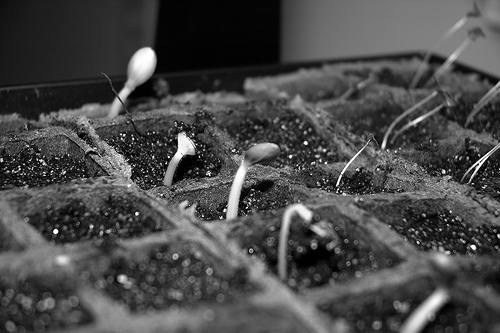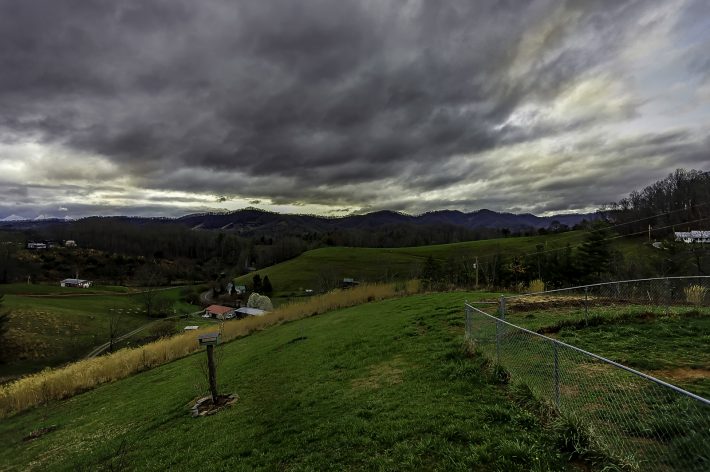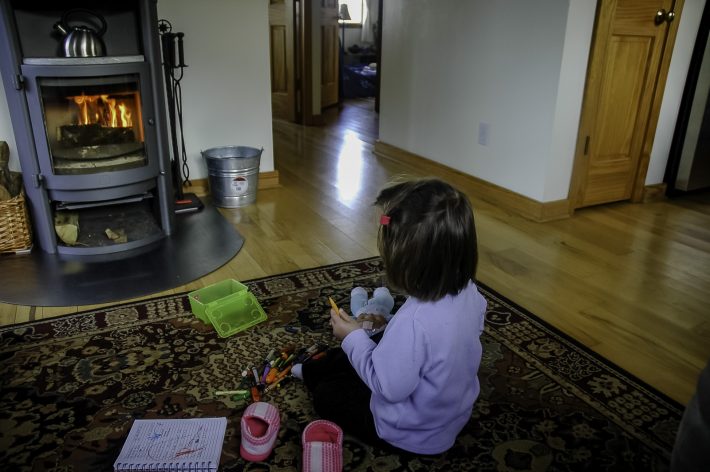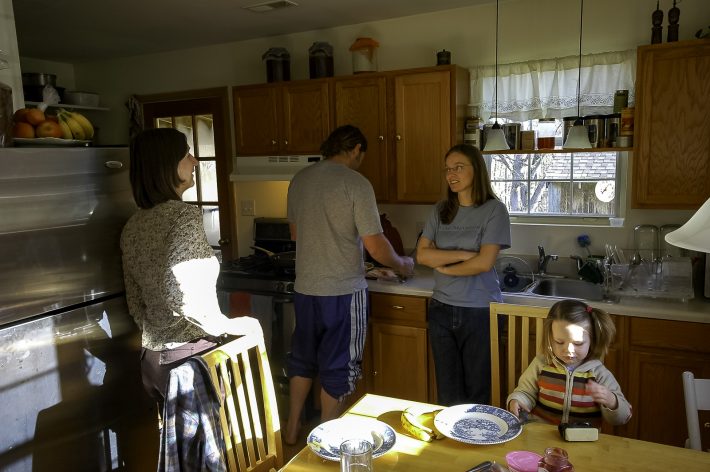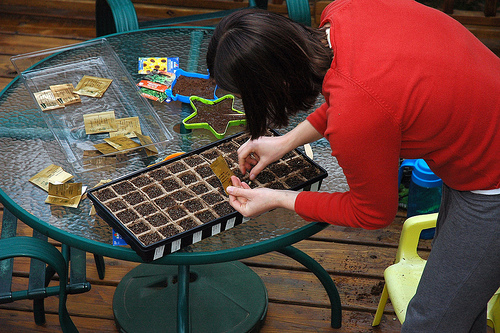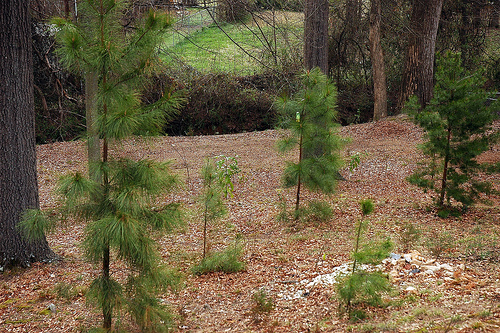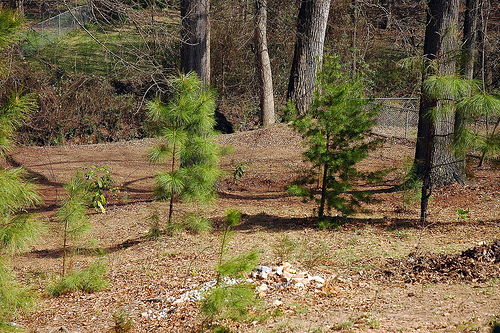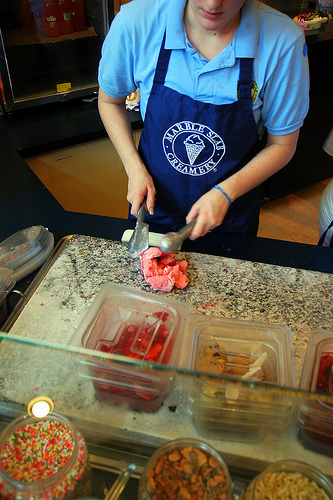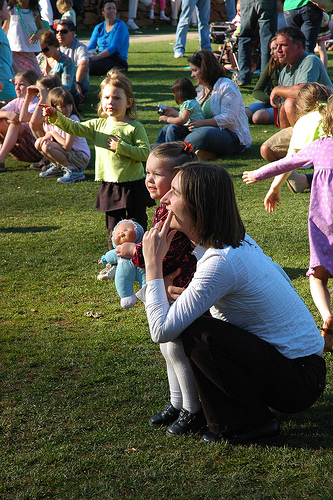In the Mountains
Waking up in the mountains, with French press of coffee and a fire filling the house with inviting, warm odors. It’s rare that the physical act of visiting friends — the actual physical being there, in this case, in the mountains — is nearly as pleasant the conversation that lasts into the early morning hours.
When we arrived, things were dark and wet.
The next morning, the opposite.
We were all up early thanks to our self-portable alarm clock. There was soon a fire burning in the stove and coffee working its magic in a press. And the conversation picked up where we’d left of the evening before.
The highlight for the Girl: animals. Four friendly dogs and twenty-some chickens made for an overjoyed little girl.
First Steps
We’ve begun our garden — sort of. We ordered seeds some weeks ago, and they finally arrived earlier this week. The first step was to get them started.
We’re both excited about hte prospect of growing our own beans, potatoes, zucchini, tomatoes, and other veggies, but we sometimes wonder if we’re biting off more than we can…
Scratch that.
Planting more than we can hoe.
I recall all the work Nana and Papa put into our garden when I was growing up, and I think, “When are we ever going to find the time.” Of course, being a teacher, I have summers off. Yet being a teacher, I also have to spend at least some of my summer expanding my horizons, so to speak — a useful euphamism for “sitting in teacher in-service sessions.”
Still, a longer day means more time to dig, which hopefully will mean more to harvest.
You’ve Got Kissibility
With Papa
Nana and Papa came over for a late lunch yesterday, which meant a string of “Yes’s” and “Of course’s” from Papa. Because we all know who always says, “Yes.”

The light was warm and the Girl was occupied; only one thing to do.
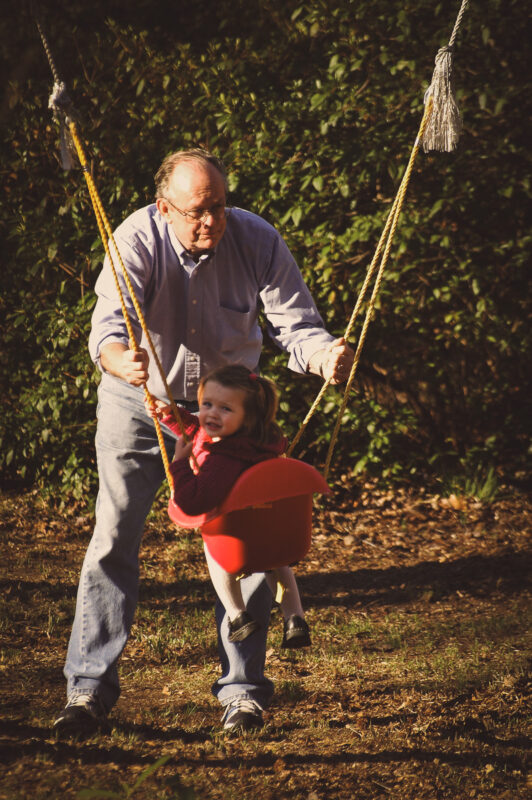
K said just yesterday, “We have so many pictures at the swing!” Portraits are supposed to reflect the subject and her personality, and what better way than to take pictures where she loves to be?
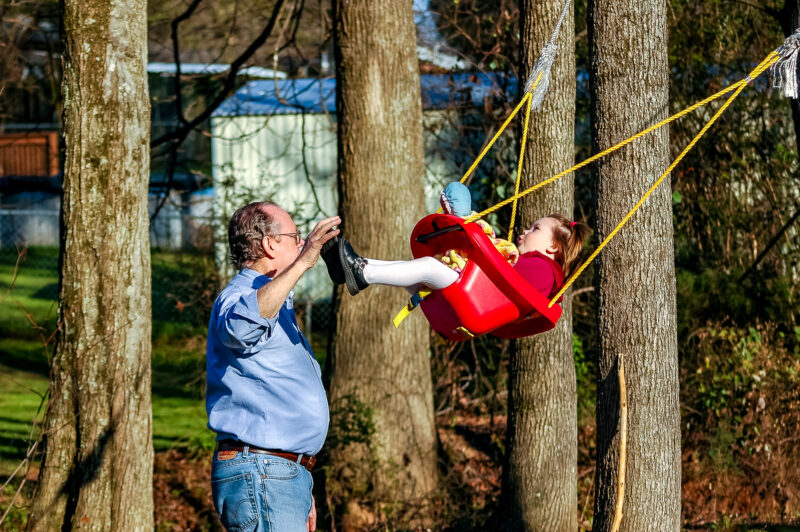
But point taken, K — enough with the swing, already!
Spring
In South Carolina, spring comes when the calendar says it does: late March. The tops of trees, where the light is most direct, already have buds beginning to open.
The tulip poplars have buds all over.
In the brush beneath the trees, there is just enough light for some blossoms.
All this inspires me finish up with the leaves that have been blanketing the ground for four months now.
A new mulching mower makes relatively quick work of the leaves (except for those in the rocky, uneven areas that remained undisturbed this time around), turning them into a powder that will improve the soil for the spring of 2011, when we think we might get around to doing something with the backyard. This spring we’re concentrating on getting veggies growing; next spring will be the front yard’s turn.
Reading
Time!
Ten or so years ago, while preparing for the GRE in Poland, I was getting frustrated with the analytical section and how rushed I felt during the practice tests. One evening, I sat down with a cup of coffee and no timing device whatsoever, and I took a practice analytical section — and completed it without a single mistake. It took me almost twice the usually allotted time for the section.
When I took the actual GRE, my analytical results were substantially lower than the perfect score of 800. I attributed this solely to time pressure, and included a note in my grad school applications to that effect: “This test, I feel, was a test not of my analytical ability, but my ability to work under artificial time restraints,” I wrote, or something similar.
Yesterday, while taking ETS’s “Principles of Learning and Teaching, Grades 7-12” Praxis test, I found my mind returning to those long-forgotten themes.
What is the point of a time limit on a professional test? I understand that the administrators don’t want examinees to be there all day, but what is the thinking behind making the time so incredibly short that everyone is frantically working up until the moment time is called?
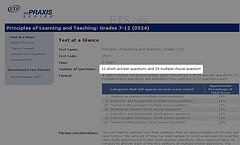
The PLT test consists of twelve short-answer questions and twenty-four multiple-choice questions. Or, as it’s put on their web site: “12 short-answer questions and 24 multiple-choice question” (my emphasis added). Those twelve “short answer” questions are divided into four scenarios, with each one having a long case history.
Here’s a sample, provided by ETS:
Case History: 7-12
Directions: The case history is followed by two short-answer questions.
Mr. Payton
Scenario
Mr. Payton teaches world history to a class of thirty heterogeneously grouped students ages fourteen to sixteen. He is working with his supervisor, planning for his self-evaluation to be completed in the spring. At the beginning of the third week of school, he begins gathering material that might be helpful for the self-evaluation. He has selected one class and three students from this class to focus on.
Mr. Payton’s first impression of the three students
Jimmy has attended school in the district for ten years. He repeated fifth and seventh grades. Two years older than most of the other students in class and having failed twice, Jimmy is neither dejected nor hostile. He is an outgoing boy who, on the first day of class, offered to help me with “the young kids” in the class. He said, “Don’t worry about me remembering a lot of dates and stuff. I know it’s going to be hard, and I’ll probably flunk again anyway, so don’t spend your time thinking about me.”
Burns is a highly motivated student who comes from a family of world travelers. He has been to Europe and Asia. These experiences have influenced his career choice, international law. He appears quiet and serious. He has done extremely well on written assignments and appears to prefer to work alone or with one or two equally bright, motivated students. He has a childhood friend, one of the slowest students in the class.
Pauline is a withdrawn student whose grades for the previous two years have been mostly C’s and D’s. Although Pauline displays no behavior problems when left alone, she appears not to be popular with the other students. She often stares out the window when she should be working. When I speak to Pauline about completing assignments, she becomes hostile. She has completed few of the assignments so far with any success. When I spoke to her counselor, Pauline yelled at me, “Now I’m in trouble with my counselor too, all because you couldn’t keep your mouth shut!”
Mr. Payton’s initial self-analysis, written for his supervisor
I attend workshops whenever I can and consider myself a creative teacher. I often divide the students into groups for cooperative projects, but they fall apart and are far from “cooperative.” The better-performing students, like Burns, complain about the groups, claiming that small-group work is boring and that they learn more working alone or with students like themselves. I try to stimulate all the students’ interest through class discussions. In these discussions, the high-achieving students seem more interested in impressing me than in listening and responding to what other students have to say. The low-achieving students seem content to be silent. Although I try most of the strategies I learn in workshops, I usually find myself returning to a modified lecture and the textbook as my instructional mainstays.
Background information on lesson to be observed by supervisor
Goals:
- To introduce students to important facts and theories about Catherine the Great
- To link students’ textbook reading to other sources of information
- To give students practice in combining information from written and oral material
- To give students experience in note taking
I assigned a chapter on Catherine the Great in the textbook as homework on Tuesday. Students are to take notes on their reading. I gave Jimmy a book on Catherine the Great with a narrative treatment rather than the factual approach taken by the textbook. I told him the only important date is the date Catherine began her reign. The book has more pictures and somewhat larger print than the textbook.
I made no adaptation for Burns, since he’s doing fine. I offered to create a study guide for Pauline, but she angrily said not to bother. I hope that Wednesday’s lecture will make up for any difficulties she might experience in reading the textbook.
Supervisor’s notes on Wednesday’s lesson
Mr. Payton gives a lecture on Catherine the Great. First he says, “It is important that you take careful notes because I will be including information that is not contained in the chapter you read as homework last night. The test I will give on Friday will include both the lecture and the textbook information.”
He tape records the lecture to supplement Pauline’s notes but does not tell Pauline about the tape until the period is over because he wants her to do the best note taking she can manage. During the lecture, he speaks slowly, watching the class as they take notes. In addition, he walks about the classroom and glances at the students’ notes.
Mr. Payton’s follow-up and reflection
Tomorrow the students will use the class period to study for the test. I will offer Pauline earphones to listen to the tape-recorded lecture. On Friday, we will have a short-answer and essay test covering the week’s work.
Class notes seem incomplete and inaccurate, and I’m not satisfied with this test as an assessment of student performance. Is that a fair measure of all they do?
From this, examinees answer three questions. They’re called “short answer” questions, but they’re really essay questions if one wants to answer the question carefully and thoroughly.
Question One
In his self-analysis, Mr. Payton says that the better-performing students say small-group work is boring and that they learn more working alone or only with students like themselves. Assume that Mr. Payton wants to continue using cooperative learning groups because he believes they have value for all students.
- Describe TWO strategies he could use to address the concerns of the students who have complained.
- Explain how each strategy suggested could provide an opportunity to improve the functioning of cooperative learning groups. Base your response on principles of effective instructional strategies.
Question Two
In the introduction to the lesson to be observed, Mr. Payton briefly mentions the modification he has or has not made for some students. Review his comments about modifications for Jimmy and Burns.
- For each of these two students, describe ONE different way Mr. Payton might have provided a modification to offer a better learning situation for each.
- Explain how each modification could offer a better learning situation. Base your explanation on principles of varied instruction for different kinds of learners.
There are two sample questions provided at ETS’s web site; on the actual test, there are three questions, each one asking for two specific examples of this or that. For each case-history essay section (like the one above, though with one more question), ETS allotted twenty-five minutes.
This might be fine if the case histories didn’t sometimes require multiple readings:
- trying to figure out things like whether Bobby is in the first group of students Mr. Tadeusz spoke with or the second group;
- wondering about the nature of the student-teacher relationship and prior interventions in a question about dealing with a disruptive student; or,
- fighting the urge to scream, “This test is ridiculous!”
Teaching is a reflective task, and often one’s first response to a situation is not the correct one. It leads me to believe that this test is only about testing how ingrained standard “first responses” are and nothing more. Indeed, any test with a severely restrictive time limit can only be testing how quickly examinees can recall and synthesize information.
One positive emerged from it all: I need to be more aware of how much time I’m giving my own students for tests and exams.
To its credit, South Carolina does not impose a time limit on its main standards-assessing test, the PASS (Palmetto Assessment of State Standard).
Big Wolf
A new story L likes to tell — Big Wolf. The premise is careful: “Big Wolf! Be careful! Run away!”
Gumkas
His Three Moons
Many years ago, when Michael Jordan came out of retirement, my best friend from high school, Dave, and I had a day of three Michaels. We watched Jordan’s game and then drove to Asheville to see Michael Hedges and Michael Manring perform at the now-defunct Be Here Now.
Hedges and Manring opened the set together, but then they took turns playing solo.
At one point, Manring comes on stage with two bass guitars hanging from his shoulders and a third in his hand. “The third one’s a hologram,” Hedges laughed as he left the stage.
Manring explained that the laws of physics and his chiropractor made it impossible to hold and play all three himself, so he asked for a volunteer. No hands. I tentatively raise mine. Before I know it, I’m on the stage. It looked something like this.
Someone in the audience took a picture and sent it to me, but it’s long lost. Not so with the memory.
This, however, is his most lovely tune:
Ice Cream and Dancing
There are few things in life the Girl likes loves more than ice cream (a new love) and dancing (an eternal love). We had a little outing Sunday that included both.
We began at the Marble Slab Creamery, where freshly made ice cream is mixed with just about anything — by hand. L wanted “pink ice cream,” which left our options somewhat limited. Fortunately, she’s wild about strawberries, and strawberry ice cream turned out to be equally popular.
She savored it.
Afterward, we wandered down to the main park, where, unbeknown to us, there was an Irish festival (St. Patty’s Day and all…), which included dancing — sure to hold the Girl’s attention.
The dancers were impressive, and L wanted to join them. K literally had to catch her just before she made it onto the stage.
Dancing lessons seem to be a definite future weeknight activity.
Dearest K and L
My girls. The women of my life. Today is your day.
No American celebrates Women’s Day. It’s not in my blood. I can’t tell you when it is like I can explain the date of Thanksgiving or tell you when swimming pools general open (i.e., Memorial Day). And so I’m prone to forget. I remembered in Polska only because I saw all males buying flowers that day and I heard about it in school.
Still, seven years in Poland — I should remember.
If I could sing you a song, I would. As it is, Peter will have to suffice.
Maybe year…
Shaking the Tree
Shaking the Tree (Maybe not all the lyrics are applicable. Still, the chorus…)
I’m off to put a reminder in Google Calendar.
The Photographer

The Girl began doing it in Poland, as we were standing outside the church, waiting to go in for her baptismal Mass. Everyone was fretting about this and that — Will the Girl be able to sit that long? Will she remain calm when taken to the altar? Will the loud singing upset her? — when L calmly walked over to the tripod and began taking pictures of everyone.
No camera necessary.
None of us realized she had a passion for photography.
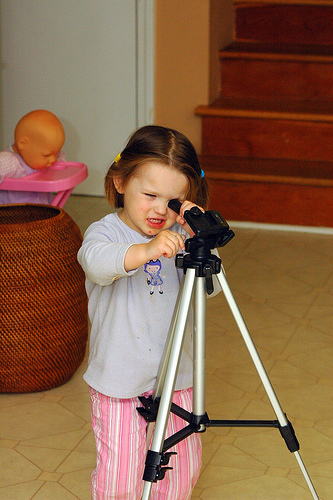
We’ve already begun discussing when to get her camera. After all, when she sees me taking a picture, she often runs over and asks to take a picture herself. Granted, the camera is almost as big as she is, and she doesn’t quite get the concept of framing a picture (she just presses the shutter release, and holds it down if I don’t switch it to single-picture mode), but she does understand the concept: she takes the picture, then thrusts the camera away from her so she can look at her work.
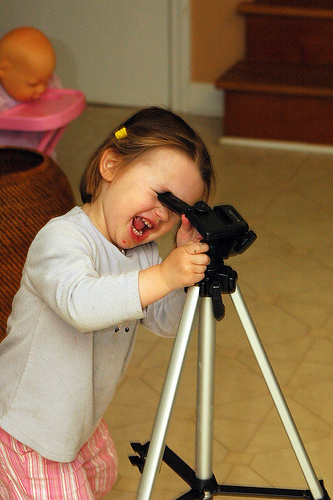
“Maybe next year,” I suggest. “When she’s three.”
“Or maybe this summer,” K says. We are planning several weekend trips this year.
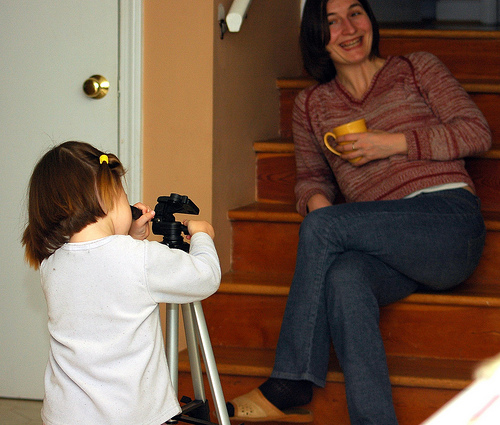
Maybe we’ll get the camera this year, and a Flickr account for her next year…
Faulty Installation
Apparently, everything in our beloved gas pack has been installed incorrectly.

This valve should be turned ninety degrees. That would prevent the droplet of water that’s clearly visible from freezing, causing the whole unit to shut down until it thaws and the unit resets. This would have saved us the cost of a service call.
Then again, if I’d simply tried to turn it on in the early afternoon, I would have found the heating works.
The Interview
It’s not the best example of her talking, but it shows how much L understands now.
Still Dancing
It has been a while since I made any videos. Six months, to be precise. The reason is simple: our computer crashed, and while re-installing the software I use to make videos, it crashed again. I’ve just been putting it off since then.
Not much catching up to do — here’s one from December. The Girl dancing to the brushing teeth song.
Candles
Disaster
We had a major accident this morning. I wasn’t there when it happened, but apparently, it was something dreadful. So dire that the Girl emerged from the bathroom with an improvised finger splint.
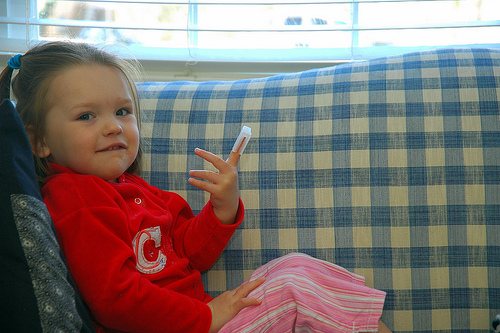

The accident involved the seal as well, for he left the bathroom/emergency room with not one, but two adhesive bandages (CVS brand, I think, not BandAid).
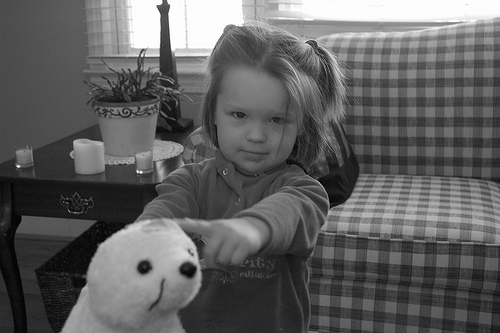
After some consultation with Dr. L, I feel confident in saying that the seal is expected to make a full recovery.
Snow Day, Redux
Sunrise on a snow day.

The trees all sag under the load. Local news reports tell of many downed trees; through the morning, I hear chainsaws in the not-so-distant distance: the city already clearing up last night’s mess.

There’s ice and snow on the early blossoms

and those that chose not to rush the season.

The Girl’s swing really stands out on the blue-white snow.

The snow certainly has confused the animals. Our cat is fascinated and annoyed with the snow. She had it easy, though: she didn’t have to look for food. Do squirrels in warm climates horde? Are they as unprepared as the locals (like the one who found a novel snow scraper).
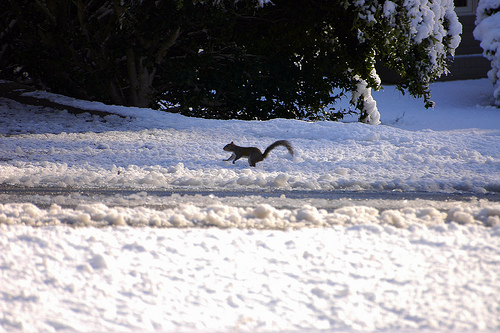
Our neighbors made a snow individual last night. Today, it’s obvious that a snow Dolly Parton would be more descriptive. They’re young, our neighbors.

It’s difficult not to look up.

Looking up all the time would be a mistake, though, because the roads are covered with ice in the early morning.

Black ice, they call it. It’ll be gone before lunch, turned to a slushy mess. Yet that probably means it will re-freeze overnight and we’ll have another day off tomorrow. Two of three built-in snow days gone.

The trees in the backyard made it through the night. It must have been paranoia on my part. After all, how often do trees come down and damage homes? How often does it really happen? Well, truth be told, we have friends in Asheville who had the corner of their house crushed by a large limb from an oak, poplar, or some such tree.

The Girl is excited, running about, looking out the windows. Sadly, it’s too slushy to take her out. She’s still sick, and without any decent shows or water-resistant clothes, she’d be soaked in minutes.
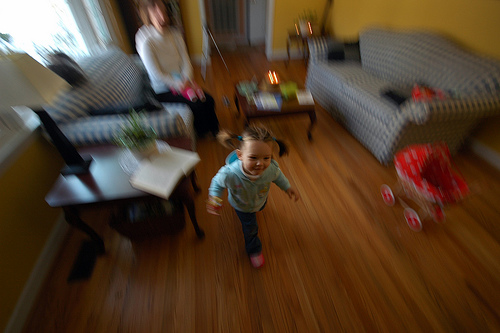
Update
From the Greenville Times:
Greenville County Schools’ offices and schools will be closed Tuesday, the second consecutive day since a snow storm walloped the Upstate, said spokesman Oby Lyles.
Eight schools throughout the county don’t have power and school officials don’t know when it will come back on, he said. Roads are icy and some secondary roads remain blocked, Lyles said. (Source)
And so tomorrow, more fun with the Girl.
